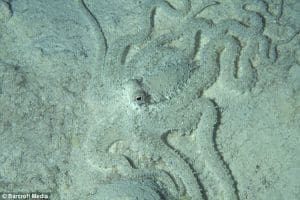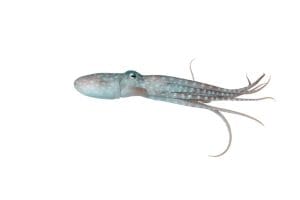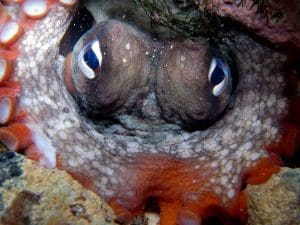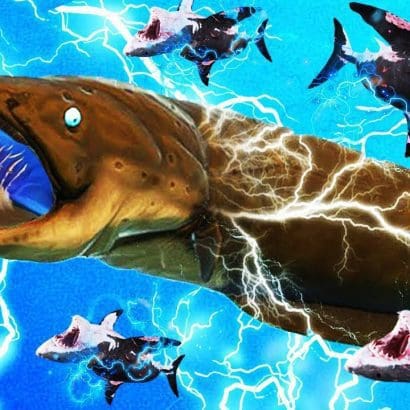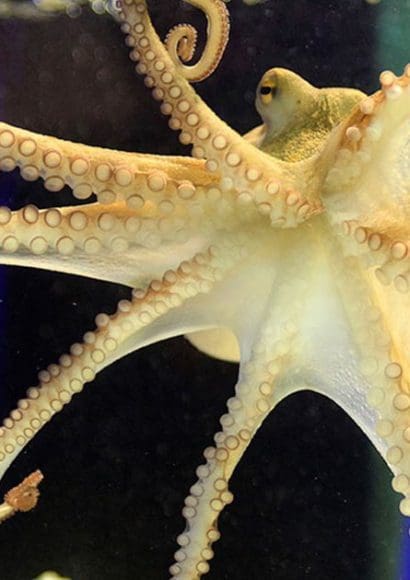
Have you ever wondered how an animal can transform itself in its environment in a matter of seconds or how it can cleverly solve problems in the ocean? The octopus, a mysterious inhabitant of the marine world, is known for its astonishing camouflage abilities and exceptional intelligence. Considered one of the most amazing animals in the animal kingdom, the octopus has fascinated scientists and nature enthusiasts alike.
In this article, we will explore the camouflage abilities and surprising intelligence of the octopus. We will discover how the octopus uses its camouflage ability to adapt to its environment and protect itself from predators, as well as how its intelligence allows it to solve problems and face challenges in its marine habitat. We will learn about the unique characteristics of the octopus that make it so special and exciting to study. Get ready to dive into the fascinating world of the octopus and discover its incredible abilities.
Contents
- Octopus Camouflage Abilities.
- How Octopuses Use Their Camouflage Abilities to Protect Themselves from Predators:
- Mimicry and Deception of the Octopus.
- How the mimicry contributes to the survival of the octopus in its habitat.
- The surprising intelligence of the octopus:
- What makes the octopus considered an intelligent animal?
Octopus Camouflage Abilities.
 The octopus is known for its astonishing ability to camouflage, allowing it to blend seamlessly with its environment and go unnoticed in the ocean. These camouflage abilities are crucial for the octopus’ survival, as they enable it to protect itself from predators and effectively stalk its prey.
The octopus is known for its astonishing ability to camouflage, allowing it to blend seamlessly with its environment and go unnoticed in the ocean. These camouflage abilities are crucial for the octopus’ survival, as they enable it to protect itself from predators and effectively stalk its prey.
Color and pattern change:
The octopus has specialized cells in its skin called chromatophores, which allow it to change color and pattern in a matter of seconds. These chromatophores contain pigments that expand or contract, allowing the octopus to alter its appearance to match its surroundings. It can adopt a wide range of colors and patterns, from bright and flashy tones to darker and more opaque tones, allowing it to blend in with its environment and confuse predators or prey.
Texture and shape:
In addition to changing color, the octopus can also alter the texture and shape of its skin to adapt to its environment. It can contract or expand small bumps called dermal papillae on its skin, allowing it to replicate the texture of its surroundings, such as rocks, corals, or seaweed. It can also change the shape of its body and the contours of its limbs to better blend in with its surroundings and resemble inanimate objects.
Behavior and posture:
Apart from its ability to change color, texture, and shape, the octopus can also adjust its behavior and posture for camouflage. It can adopt specific postures to mimic objects in its environment, such as resting on the ocean floor to appear as a rock or curling up to resemble seaweed. It can also adjust its movement and speed to blend in with the water movement or resemble other marine animals.
How Octopuses Use Their Camouflage Abilities to Protect Themselves from Predators:
The octopus’s remarkable camouflage abilities play a crucial role in protecting it from predators in the ocean. Here’s how the octopus utilizes its camouflage abilities to stay hidden and avoid becoming prey:
Blending with the surroundings:
 Octopuses can rapidly change the color, pattern, texture, and shape of their skin to blend in with their environment. When a predator approaches, the octopus can quickly adjust its appearance to match the colors and patterns of the rocks, corals, or seaweed around it. By blending in, the octopus becomes virtually invisible to its predators, making it extremely difficult for them to detect it and increasing its chances of survival.
Octopuses can rapidly change the color, pattern, texture, and shape of their skin to blend in with their environment. When a predator approaches, the octopus can quickly adjust its appearance to match the colors and patterns of the rocks, corals, or seaweed around it. By blending in, the octopus becomes virtually invisible to its predators, making it extremely difficult for them to detect it and increasing its chances of survival.
Mimicking other marine animals:
Octopuses are known for their ability to mimic other marine animals using their camouflage skills. For example, an octopus may mimic the appearance and movement of a toxic or venomous animal, such as a lionfish or a sea snake, to deter potential predators. By imitating dangerous animals, the octopus sends a clear message to predators that it is not an easy target and should be avoided.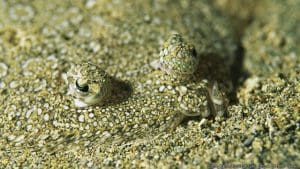
Creating distractions:
Octopuses can also use their camouflage abilities to create distractions and confuse predators. For instance, they may rapidly change the color and pattern of their skin in one part of their body while moving in a different direction with the rest of their body. This can confuse predators and divert their attention away from the octopus, allowing it to escape to safety.
Using body posture:
The octopus can also use its body posture to enhance its camouflage. It can change the shape of its body and limbs to resemble inanimate objects or blend in with the surrounding environment. For example, it may flatten its body and spread out its arms to mimic a rock or a piece of coral. This body posture combined with its color-changing abilities makes the octopus incredibly adept at staying hidden from predators.
Mimicry and Deception of the Octopus.
In addition to their camouflage abilities, octopuses are also known for their ability to mimic and deceive. These strategies allow them to deceive their predators and prey, providing them with an advantage in obtaining food and avoiding becoming prey. Here is more information about the mimicry and deception of the octopus: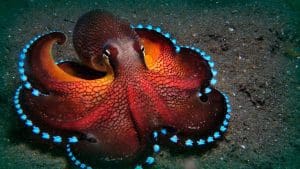
Mimicry:
Octopuses have the ability to mimic other marine organisms to confuse their predators or prey. For example, some octopuses can mimic species of fish or marine animals, adopting their shape, color, and patterns to resemble them. This mimicry allows them to approach their prey without being detected or deter their predators by appearing as an unappetizing or dangerous organism.
Use of false signals:
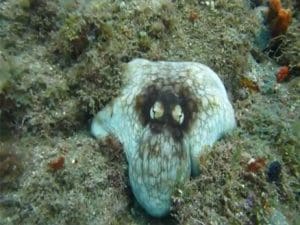 Octopuses can also use false signals to confuse their predators or prey. For instance, they may display warning signals such as bright color changes or threatening patterns to deter predators from attacking them. These false signals can make predators think that the octopus is dangerous or venomous, keeping them away from attempting to prey on it.
Octopuses can also use false signals to confuse their predators or prey. For instance, they may display warning signals such as bright color changes or threatening patterns to deter predators from attacking them. These false signals can make predators think that the octopus is dangerous or venomous, keeping them away from attempting to prey on it.
How the mimicry contributes to the survival of the octopus in its habitat.
Mimicry is an astonishing ability that the octopus uses to camouflage and adapt to its environment. This ability of mimicry greatly contributes to the survival of the octopus in its natural habitat. Here is more information on how this mimicry ability benefits the octopus: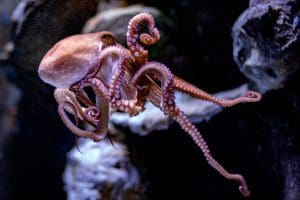
- Protection against predators: Mimicry allows the octopus to blend in and confuse its surroundings, which helps it protect itself from predators. By adopting the appearance of its environment, through changes in color, texture, and pattern of its skin, the octopus becomes less detectable to predators that may be stalking it. This allows it to avoid detection and attack from potential threats, increasing its chances of surviving in its habitat.
- Prey capture: Mimicry also helps the octopus in capturing its prey. By adopting the appearance of other marine organisms, the octopus can stealthily approach its prey without alerting them, allowing it to surprise them and capture them more effectively. For example, by mimicking a rock, a marine plant, or a harmless organism, the octopus can lure unsuspecting prey and take advantage of their confusion to successfully hunt.

- Adaptation to different environments: The mimicry ability of the octopus allows it to adapt to a wide range of marine environments. Octopuses can quickly adjust their appearance to match the characteristics of their environment, whether it’s a coral reef, a seagrass meadow, or a sandy seabed. This allows them to blend in with their surroundings and go unnoticed, which is crucial for their survival in diverse and changing habitats.
- Conflict avoidance: Mimicry can also help the octopus avoid conflicts with other marine organisms. By adopting the appearance of organisms that are perceived as dangerous or unappetizing by other organisms, the octopus can deter potential competitors or predators from attacking it. This allows it to avoid unnecessary confrontations and reduce the risks associated with interacting with other organisms in its habitat.
The surprising intelligence of the octopus:
The octopus is known for its incredible cognitive ability and surprising intelligence, making it one of the most fascinating animals in the marine kingdom. Here is information about the astonishing intelligence of the octopus:
- Adaptation to the environment: The octopus has a remarkable ability to adapt to its environment. It can solve complex problems related to feeding, obtaining shelter, and evading predators. For example, octopuses have been observed opening jars, manipulating objects, and using improvised tools to reach their goals. They can also modify their environment by rearranging objects or constructing improvised structures to protect themselves or capture prey.
- Hunting behavior: The octopus uses astonishing and diverse hunting strategies. It can camouflage and mimic its surroundings to ambush its prey. It can also use ambush techniques, such as burying its body in the sand or in a hole and patiently waiting for the prey to approach close enough to capture it. Some species of octopuses even use decoys or deception to lure their prey, such as waving their arms or mimicking the appearance of a desirable prey to attract other animals.
- Memory and learning: Octopuses have an amazing memory and are capable of learning quickly and efficiently. It has been shown that they can remember the location of their home, recognize individuals of their species, and learn from previous experiences to improve their hunting strategies. They are also capable of adapting to new and unknown situations, demonstrating their ability to learn and apply knowledge in their environment.

- Communication and problem-solving: Octopuses have been found to communicate with each other through visual, tactile, and chemical signals. They can also solve complex problems to obtain rewards, such as accessing hidden food in hard-to-reach places. Studies have shown that octopuses are capable of learning and applying different strategies to problem-solving, demonstrating their impressive intelligence and ability to adapt to changing situations.

- Innovative behaviors: Octopuses have also shown innovative and creative behaviors. They have been observed improvising and finding solutions to difficult or unexpected situations. For example, some octopuses have been observed using shells, coconuts, or other objects as shelter or protection. These innovative behaviors indicate a surprising intelligence and ability to find solutions to the challenges of the marine environment.
What makes the octopus considered an intelligent animal?
The octopus is considered an intelligent animal due to a wide range of remarkable characteristics and behaviors it exhibits. Its ability for camouflage and mimicry, adaptation to the environment, problem-solving skills, memory and learning ability, social communication, and innovative and creative behaviors are some of the aspects that make the octopus highly intelligent.
The octopus uses its camouflage ability to protect itself from predators and effectively ambush its prey. Its ability to blend in with its surroundings, change color and texture, and use patterns and shapes to blend with its environment allows it to evade predators and ambush its prey.
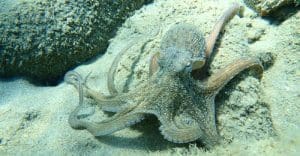 Furthermore, the octopus shows surprising adaptation to its environment, modifying its surroundings for its benefit and using improvised tools to achieve its goals, such as opening jars or constructing temporary shelters.
Furthermore, the octopus shows surprising adaptation to its environment, modifying its surroundings for its benefit and using improvised tools to achieve its goals, such as opening jars or constructing temporary shelters.
The memory and learning ability of the octopus are also noteworthy. Studies have shown that octopuses can remember the location of their home, recognize individuals of their species, and learn from past experiences to improve their hunting and survival strategies.
The octopus also exhibits communication skills, using visual, tactile, and chemical signals to interact with other individuals of its species, indicating a level of social intelligence and communication.
In addition, the octopus shows problem-solving skills, adapting to new and unknown situations and demonstrating innovative and creative behavior to overcome challenges.
👀 If you want to learn about some octopus recipes, I invite you to click here.

